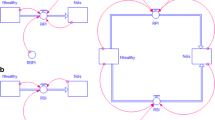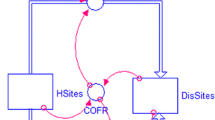Abstract
The role of initial inoculum (yo), rate (r) of pathogen or disease development (infection), and period of time (t) that the pathogen and host populations interact during the cropping period is revisited in modeling plant disease epidemics. The importance of quantitative informations and the relationship between initial inoculum and the rate of disease development represent key elements for identification of the most useful disease models to be used. For effective Integrated Disease Management of monocyclic or polycyclic epidemics, temporal population growth models of plant disease epidemics (monomolecular, exponential, logistic and Gompertz population models) are presented. Sanitation and disease management principles (exclusion, avoidance, eradication, protection, resistance and therapy) are described. Finally, the integration of IPM practices, at the disease components level, with Lieberg’s Law of the Minimum is discussed.
Access this chapter
Tax calculation will be finalised at checkout
Purchases are for personal use only
Preview
Unable to display preview. Download preview PDF.
Similar content being viewed by others
References
Bandyopadhyay, R., & Frederiksen, R. A. (1999). Contemporary global movement of emerging plant disease. Pages 28–36 in: Food and Agricultural Security: Guarding Against Natural Threats and Terrorist Attacks Affecting Health, National Food Supplies, and Agricultural Economics. Frazier, T. W. and Richardson, D. C. (Eds.). New York Academy of Sciences, New York.
Bau, H. J., Cheng, Y. H., Yu, T. A., Yang, J. S., Liou, P. C., Hsiao, C. H., et al. (2004). Field evaluation of transgenic papaya lines carrying the coat protein gene of Papaya ringspot virus in Taiwan. Plant Disease, 88, 594-599.
Bruehl, G. W., (Ed.) (1975). Biology and control of soil-borne plant pathogens. American Phytopathological Society, St. Paul, Minnesota, USA.
Campbell, A. I. (1962). Apple virus inactivation by heat therapy and tip propagation. Nature, 195, 520.
Campbell, C. L., & Madden, L. V. (1990). Introduction to plant disease epidemiology. John Wiley, New York, 532 pp.
Chatrath, M. S. (1970). Radiation therapy of loose smut of wheat and barley. In: Plant Disease Problems. Raychaudhuri, S. P. et al. (Eds.). Indian Phytopathological Society, New Delhi, 483-488.
Coelho, L., Chellemi, D. O., & Mitchell, D. J. (1999). Efficacy of solarization and cabbage amendment for the control of Phytophthora spp. in North Florida. Plant Disease, 83, 293-299.
Coelho Netto, R. A., & Nutter, F. W. Jr. (2005). Use of GPS and GIS technologies to map the prevalence of Moko disease of banana in the Amazonas region of Brazil. 3rd International Bacterial Wilt Symposium, White River, South Africa, APS Press, St. Paul, MN, 431-436.
Cook, R. J. (1977). Management of the associated microbiota. In: Plant disease: an advanced treatise. Vol. 1. Horsfall, J. G., & Cowling , E. B. (Eds.). Academic Press, New York, 145-166.
Davis, M. J., & Ying, Z. (2004). Development of papaya breeding lines with transgenic resistance to Papaya ringspot virus. Plant Disease, 88, 352-358.
Du Toit, L. J., & Hernandez-Perez, P. (2005). Efficacy of hot water and chlorine for eradication of Cladosporium variable, Stemphylium botryosum and Verticillium dahliae from spinach seed. Plant Disease, 89, 1305-1312.
Esker, P. D., & Nutter, F. W., Jr. (2003). The temporal dynamics of flea beetle populations infested with Pantoea stewartii, the causal agent of Stewart’s disease of corn. Phytopathology, 93, 210-218.
Esker, P. D., Harri, J., Dixon, P. M., & Nutter, F. W., Jr. (2006a). Comparison of models for forecasting of Stewart’s disease of corn in Iowa. Plant Disease, 90, 1353-1357.
Esker, P. D., Gibb, K. S., Padovan, A., Dixon, P. M., & Nutter, F.W., Jr. (2006b). Use of survival analysis to determine the post-incubation time-to-death of papaya due to yellow crinkle disease in Australia. Plant Disease, 90, 102-107.
Esker, P. D., Dixon, P. M., & Nutter, F. W., Jr. (2007). Effects of planting date and seed insecticides on the reduction of Stewart’s disease of corn in Iowa. Plant Disease 91, in print.
Fegan, R. M., Olexa, M. T., & McGovern, R. J. (2004). Protecting agriculture: The legal basis of regulatory action in Florida. Plant Disease, 88, 1040-1043.
Fry, W. E. (1975). Integrated effects of the polygenic resistance and a protective fungicide on development of the potato blight. Phytopathology, 65, 908-911.
Fry, W. E. (1977). Integrated control of potato late blight. - Effects of polygenic resistance and techniques of timing fungicide applications. Phytopathogy, 67, 415-420.
Fry, W. E. (1982). Principles of plant disease management. Academic Press, Inc. London.
Gottwald, T. R., Hughes, G., Graham, J. H., Sun, X., & Riley, T. (2001). The citrus canker epidemic in Florida: the scientific basis of regulatory eradication policy for an invasive species. Phytopathology, 91, 30-34.
Johnson, C. S., Beute, M. K., & Ricker, M. D. (1986). Relationship between components of resistance and disease progress of early leaf spot on Virginia-type peanut. Phytopathology, 76, 495-499.
Jones, A. T. (1979). Further studies on the effect of resistance to Amphorophora idaei in raspberry (Rubus idaeus) on the spread of aphid-borne viruses. Annals of Applied Biology, 92, 119-123.
Kuhn, C. W., Nutter, F. W. Jr., & Padgett, G. B. (1989). Multiple levels of resistance to tobacco etch virus in pepper. Phytopathology 79, 814-818.
Labrinos, J. L., & Nutter, F. W., Jr. (1993). Effects of protectant versus a systemic fungicide on disease components of late leaf spot of peanut. Plant Disease, 77, 837-845.
Lipps, P. E. (1985). Influence of inoculum from buried and surface corn residues on the incidence and severity of corn anthracnose. Phytopathology, 75, 1212-1216.
Madden, L. V. (1980). Quantification of disease progression. Protection Ecology, 2, 159-176.
Madden, L. V. & Nutter, F. W., Jr. (1995). Modeling crop losses at the field scale. Canadian Journal of Plant Pathology, 17, 174-185.
Mills, F. D., Jr., & Nutter, F. W., Jr. (1991). Late leaf spot control: can the costs be reduced? The Peanut Grower, 3, 36.
Mol, L., Scholte, K., & Vos, J.(1995). Effects of crop rotation and removal of crop debris on the soil population of two isolates of Verticillium dahliae. Plant Pathology, 44, 1070-1074.
Mueller, D. S., Gleason, M. L., Sisson, A. J., & Massman, J. M. (2006). Effect of row covers on suppression of bacterial wilt of muskmelon in Iowa. Plant Health Progress, online at http://www.plantmanagementnetwork.org/php/elements/sum2.asp?id=5644.
Naylor, V. D., & Leonard, K. J. (1977). Survival of Colletotrichum graminicola in infected corn stalks in North Carolina. Plant Disease Reporter, 61, 382-383.
Nutter, F. W., Jr. (2001). Disease assessment terms and concepts. In: Encyclopedia of Plant Pathology. Maloy, O. C. & Murray, T. D. (Eds.). John Wiley and Sons, Inc., New York, 312-323.
Nutter, F. W., Jr., Teng, P. S., & Shokes, F. M. (1991). Disease assessment terms and concepts. Plant Disease, 75, 1187-1188.
Nutter, F. W. Jr. (1993). Quantification of components contributing to rate-reducing resistance in a plant-virus pathosystem. In: Systems approaches to agricultural development. Penning de Vries, F., Teng, P. S., & Metselaar, K. (Eds.). Kluwer Academic, The Netherlands, 297-308.
Nutter, F. W., Jr. (1997). Quantifying the temporal dynamics of plant viruses: a review. Crop Protection, 16, 603-618.
Nutter, F. W., Jr. (1999). Understanding the interrelationships between botanical, human, and veterinary epidemiology: The Y’s and R’s of it all. Ecosystem Health, 5, 131-140.
Nutter, F. W., Jr., & Madden, L. V. (2005). Plant disease as a possible consequence of biological attacks. In: Biological Terrorism. Greenfield, R. A., & Bronze, M. S. (Eds.). Horizon Scientific Press, Caister Scientific Press, Norfolk, UK, 793-818.
Nutter, F. W., Jr., & Mills, F. D. (1990). Cost/benefit comparison of a weather-based fungicide scheduling program versus a calendar spray program to control late leafspot of peanut. Phytopathology, 80, 989.
Nutter, F. W., Jr., Cole, H., Jr., & Schein, R. D. (1983). Disease forecasting system for warm weather Pythium blight of turfgrass. Plant Disease, 67, 1126-1128.
Nutter, F. W., Jr., & Guan, J. (2001). Disease losses. In: Encyclopedia of Plant Pathology. Maloy, O. C., & Murray, T. D. (Eds.). John Wiley and Sons, Inc., New York, 340-351.
Nutter, F. W. & Parker, S. K. (1997). Fitting disease progress curves using EPIMODEL. In: Exercises in plant disease Epidemiology. Francl, L. J., & Neher, D. A. (Eds.). APS Press, St. Paul, MN, 24-28.
Nutter, F. W., Jr., Rubsam, R. R., Taylor, S. E., Harri, J. A., & Esker, P. D. (2002). Geospatially-referenced disease and weather data to improve site-specific forecasts for Stewart’s disease of corn in the U.S. corn belt. Computers and Electronics in Agriculture, 37, 7-14.
Padgett, G. B., Nutter, F. W. Jr., Kuhn, C. W. & All, J. N. (1990). Quantification of disease resistance that reduces the rate of tobacco etch virus epidemics in bell pepper. Phytopathology, 80, 451-455.
Parlevliet, J. E. (1979). Components of resistance that reduce the rate of epidemic development. Annual Review of Phytopathology, 17, 203-222.
Palti, J. (1981). Cultural practices and infectious crop diseases. Springer-Verlag Berlin Heidelberg, New York.
Peterson, P. D., Leonard, K. J., Roelfs, A. P., & Sutton, T. B. (2005). Effect of barberry eradication on changes in populations of Puccinia graminis in Minnesota. Plant Disease, 89, 935-940.
Pimentel, D., Lach, L., Zuniga, R., & Morrison, D. (2000). Environmental and economic consts associated with non-indigenous species in the United States. BioScience, 50, 53-65.
Raychaudhuri, S. P. & Verma, J. P. (1977). Therapy by heat, radiation, and meristem culture. In: Plant disease: an advanced treatise. Vol. 1. Horsfall, J. G. & Cowling E. B., (Eds.). Academic Press, New York, 177-189.
Savary, S., Teng, P. S., Willocquet, L., & Nutter, F.W., Jr. (2006). Quantification and modeling of crop losses: a review of purposes. Annual Review of Phytopathology, 44, 89-112.
Sharvell, E. G. (1979). Plant disease control. The AVI Publishing Company. Westport, Connecticut.
Sill, W. H., Jr. (1982). Plant protection: an integrated interdisciplinary approach. The Iowa State University Press, Ames, Iowa.
Steinlage, T. A., Hill, J. H., & Nutter, F. W., Jr. (2002). Temporal and spatial spread of soybean mosaic virus (SMV) in soybeans transformed with the coat protein gene of SMV. Phytopathology, 92, 478-486.
Tennant, P., Gonsalves, C., Ling, K., Fitch, M. M. M., Manshardt, R. M., Slightom, J. L., & Gonsalves, D. (1994). Transgenic papaya expressing coat protein gene of a Hawaiian isolate of papaya ringspot virus and a classically cross-protected papaya show limited protection against isolates from different geographical regions. Phytopathology, 84, 1359-1366.
Ullstrup, A. J. (1972). The impacts of the southern corn leaf blight epidemics of 1970-1971. Annual Review of Phytopathology, 10, 37-50.
Van der Plank, J. E. (1963). Plant disease: epidemics and control. Academic Press, New York.
Waggoner, P. E., Norvell, W. A., & Royle, D. J. (1980). The Law of the Minimum and the relation between pathogen, weather, and disease. Phytopathology,70, 59-64.
Wang, X., Eggenberger, A. L., Nutter, F. W., Jr., & Hill, J. H. (2001). Pathogen-derived transgenic resistance to soybean mosaic virus in soybean. Molecular Breeding, 8, 119-127.
Ward, J. M. J, Stromberg, E. L., Nowell, D. C., & Nutter, F. W., Jr. (1999). Gray leaf spot: a disease of global importance in maize production. Plant Disease, 83, 884-895.
Zadoks, J. C., & Schein, R. D. (1979). Epidemiology and plant disease management. Oxford University Press, Inc., New York, 427 pp.
Zadoks, J. C. (1985). On the conceptual basis of crop loss assessment: the threshold theory. Annual Review of Phytopathology, 23, 455-473.
Author information
Authors and Affiliations
Editor information
Editors and Affiliations
Rights and permissions
Copyright information
© 2007 Springer
About this chapter
Cite this chapter
Nutter, F.F. (2007). The Role of Plant Disease Epidemiology in Developing Successful Integrated Disease Management Programs. In: Ciancio, A., Mukerji, K.G. (eds) General Concepts in Integrated Pest and Disease Management. Integrated Management of Plants Pests and Diseases, vol 1. Springer, Dordrecht. https://doi.org/10.1007/978-1-4020-6061-8_3
Download citation
DOI: https://doi.org/10.1007/978-1-4020-6061-8_3
Publisher Name: Springer, Dordrecht
Print ISBN: 978-1-4020-6060-1
Online ISBN: 978-1-4020-6061-8
eBook Packages: Biomedical and Life SciencesBiomedical and Life Sciences (R0)




